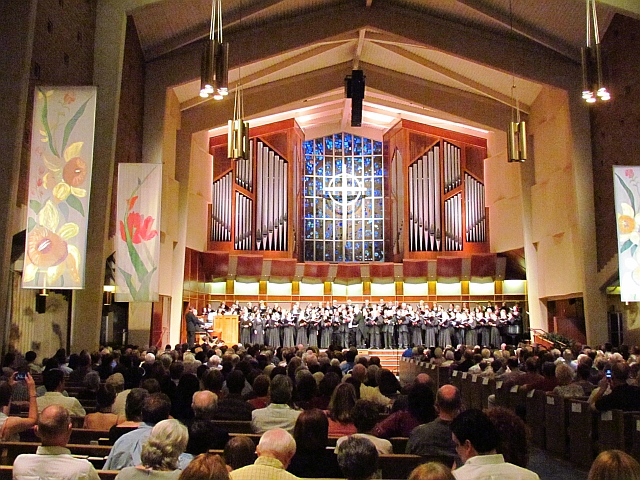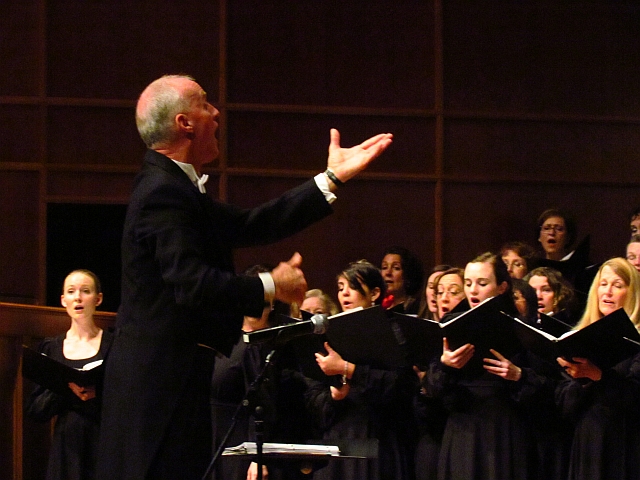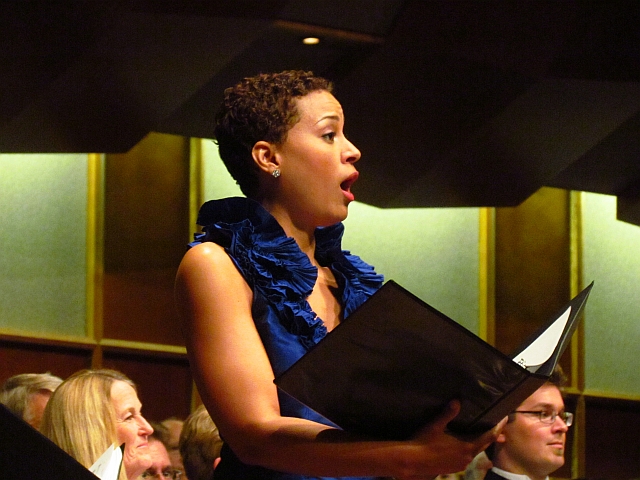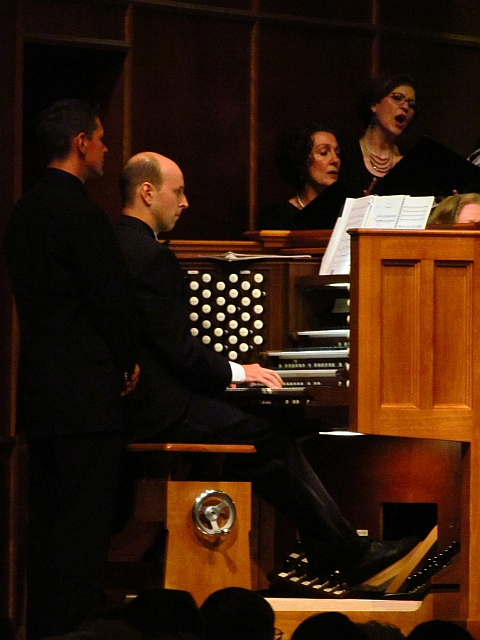Concert Review
Sacramento Choral Society & Orchestra
Stained Glass Concert Two: European Traditions - June 2, 2012
Performed at Fremont Presbyterian Church, this last concert of the Sacramento Choral Society & Orchestra’s 2011-2012 season was titled “European Traditions,” though in this program, those traditions carried into the New World. This season’s offerings by the SCSO have been extraordinarily diverse — with 4 venues, different complements of performers, and very distinctive programs of music. What was unique about this concert was that, with one exception, the only accompaniment was provided by the church’s organ. And what an organ! The Reuter organ was dedicated last year, and it is the largest organ in Sacramento, in fact the largest between the San Francisco Bay Area and Salt Lake City, with 4 manuals, 67 ranks of pipes (creating 67 unique sounds), and a total of 3901 pipes, of which only 80 are visible (and those are pretty impressive looking). For more on the organ, follow this link.

Predictably, a significant part of this night’s program was an organ concert, with three organ solos, including the one by Bach that began the program. (Click here to view a list of the organ and choral pieces performed; click here to view the entire concert program.) At the organ console was Dr. Ryan Enright, who has been named the new accompanist for the SCSO, while maintaining his role as organist for St. John’s Lutheran Church. (More on his contribution to the evening later.)
Conductor Donald Kendrick introduced the concert as a “sampler program,” and the 14 compositions performed represented many periods, with works by Vivaldi, Mendelssohn, Bruckner, Mozart, C.P.E. Bach, Vaughan Williams and others. At various points, Dr. Kendrick gave what might be described as “director’s notes,” alerting the audience as to what they should listen for in the several pieces to follow. As he spoke, he did not come across as an erudite academician. Certainly, he gave valuable insights into the structure of these pieces and their emotional highlights, along with background on the composers and their place in the evolution of music history. But what struck me in this background information was the same passion and humanity which characterizes his directing.

The first contribution of the chorus to the concert was distinctive in that they performed the Vivaldi surrounding the audience. This was no small feat, since Fremont Presbyterian is very deep, and the speed of sound must be taken into consideration. Every singer must follow the director precisely, rather than trying to match the sounds they may be hearing from hundreds of feet away. With this in mind, the fugue at the end of the piece had to be especially difficult to perform, yet I didn’t notice the vocal parts being out of phase with one another. And it has to be said that this presentation of “quadraphonic sound” gave the audience an extraordinarily rich experience. What better place to listen to a chorus than at its center? This is a gift that even chorus members don’t get because they have to sing, instead of being able to listen.

The Vivaldi also marked the introduction of soprano soloist, Katherine Jolly, who performed beautifully, with clear, accurate tones, and no small measure of grace. I must confess to a bit of disappointment, though, because resonant as the church was, Ms. Jolly and the other vocal soloists seemed overpowered by the 180-voice chorus and the organ. I would have appreciated their performance even more if there had been a bit of amplification.
The chorus sound, on the other hand, filled that large space when called on to sing forte. And the effect was especially thrilling when they sang a cappella. But the more delicate singing was also effective, and I was surprised how many of the words I could understand, considering the resonance of the church, the large number of singers, and my considerable distance from them.
There is so much that could be said about this very diverse program. A pair of cellos added a special richness to the very mellow Mendelssohn piece. The Haydn (J.M. Haydn, not F.J. Haydn) was joyful and exuberant. Indeed, there was a great variety in style, format of presentation, and mood in the various pieces. I was surprised to see two spirituals performed, considering that the rest of the program was classical or at least in the classical tradition. Yet these spirituals were highlights in every sense. René Clausen’s “Deep River” was rich and calming. And Moses Hogan’s “I’m Gonna Sing ‘Til the Spirit Moves” (performed by the chorus from memory) had great excitement and emotional range. That rousing piece saw the SCSO and soloist morph into a darned good gospel choir.
There are two more of the choral pieces that stood out especially to me. One was Randall Thompson’s “Alleluia.” The quality of a great chorus is best demonstrated when they perform a cappella, and this a cappella piece certainly showed what this chorus is capable of. And then there was Bruckner’s “Locus Iste.” The text translates as “This place was made by God, a priceless mystery; it is without reproof.” Anyone who was familiar with the piece or who consulted the translation in the program, would have been awed by the appropriateness of this surpassingly beautiful music, in this surpassingly beautiful church.
At key points in the concert, the three organ solos gave the chorus (and Director Kendrick) a rest — they were on their feet for more than an hour and a half! But organist Ryan Enright got practically no rest, accompanying nearly every piece on the program. His solos, though, were displays of exceptional virtuosity, while also showing the power and range of the instrument at his disposal. There must have been something truly special in his final solo, the piece by Marcel Dupré, because as Dr. Enright approached the conclusion, the gentleman who was turning pages for him broke into a broad smile. I would have loved to have known what transpired between them.

It was no surprise that the audience that nearly filled this large church rose to their feet in applause at the end of the concert. They appreciated the rich variety of this engaging program of music that so well demonstrated the flexibility, range, and talent of chorus, director, accompanist, and soloists. Two magnificent instruments were on display this evening — one expertly played and the other expertly directed.